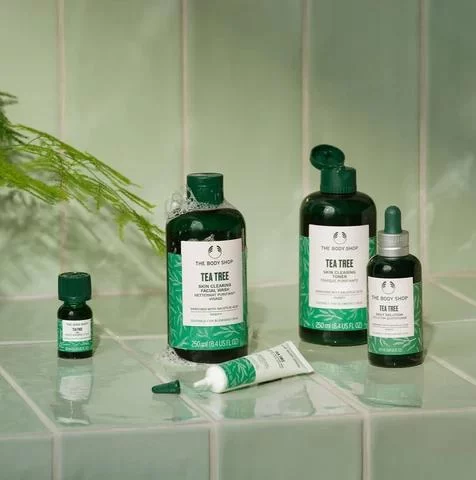- Steam-Distilled Tea Tree Oil Overview
- Skincare Benefits and Uses
- Health Applications and Precautions
- Practical Home Uses and Tips
- Finding Quality Tea Tree Oil
1. Steam-Distilled Tea Tree Oil Overview
Steam-distilled tea tree oil is extracted from the leaves of the Melaleuca alternifolia plant through a process that uses steam to gently separate the essential oils. This traditional distillation method preserves the oil’s natural potency and aromatic compounds, making it a preferred choice for both therapeutic and cosmetic applications. The purity and high concentration of active ingredients in steam-distilled tea tree oil set it apart from other extraction methods, ensuring maximum effectiveness.
Tea tree oil has a rich history of use in traditional Australian Aboriginal medicine, where it was applied for treating wounds and infections. Today, its applications have expanded globally, especially in the realm of natural skincare and holistic health, thanks to its well-documented antimicrobial and anti-inflammatory properties.
1.1 Why Steam Distillation Matters
The choice of steam distillation over cold-pressing or solvent extraction ensures that the beneficial terpinen-4-ol and other key compounds remain intact. These components contribute to tea tree oil’s remarkable ability to combat bacteria, fungi, and viruses, which explains its widespread use in various treatments.
1.2 Common Misconceptions
Many users confuse steam-distilled tea tree oil with synthetic or diluted versions that often flood the market. Authentic steam-distilled oil is clear to pale yellow, highly fragrant, and should never be ingested without expert guidance due to its potency. Understanding these differences is crucial when selecting products for health or beauty routines.
2. Skincare Benefits and Uses
Steam-distilled tea tree oil has gained fame as a natural powerhouse in skincare, particularly for acne-prone and sensitive skin. Its antibacterial and anti-inflammatory effects help reduce redness, swelling, and the formation of pimples, making it a favorite ingredient in many natural acne treatments.
2.1 Combatting Acne with Tea Tree Oil
Acne occurs primarily due to clogged pores and bacterial growth. Tea tree oil’s antimicrobial properties make it an effective topical solution to keep skin clear without the harsh side effects of conventional chemical treatments. A 2017 clinical study showed that a 5% tea tree oil gel significantly reduced acne lesions, with fewer side effects compared to benzoyl peroxide.
For practical use, dilute tea tree oil with a carrier oil like jojoba or coconut oil before applying it to the skin to prevent irritation. Users often share stories of how a simple spot treatment with diluted steam-distilled tea tree oil transformed their complexion over weeks.
2.2 Soothing Other Skin Conditions
Beyond acne, tea tree oil helps soothe minor cuts, insect bites, and fungal infections such as athlete’s foot. Its ability to reduce inflammation while preventing infection makes it an ideal first-aid staple. For example, a popular anecdote among hikers is carrying a small bottle of tea tree oil to treat blisters or insect bites naturally during outdoor adventures.
3. Health Applications and Precautions
Tea tree oil’s uses extend beyond skincare into broader health applications. Its antiviral and antifungal activities can support immune health and respiratory wellness when used appropriately.
3.1 Respiratory Support and Aromatherapy
When diffused, steam-distilled tea tree oil may help alleviate congestion and support clearer breathing by reducing airborne pathogens. Aromatherapists often recommend it as a natural remedy during cold seasons or for those prone to sinus issues. However, it should always be used in moderation and never applied directly to mucous membranes.
3.2 Safety Considerations
Despite its benefits, tea tree oil requires careful handling. It is highly concentrated and can cause allergic reactions or skin irritation if used undiluted. Importantly, it should never be ingested or applied internally without professional supervision. Children and pregnant women should consult healthcare providers before use. At Scent Snob, you can find expert advice and the purest steam-distilled tea tree oil products to ensure safe and effective use.
4. Practical Home Uses and Tips
Tea tree oil’s versatility makes it a natural choice for various household uses beyond personal care.
4.1 Natural Cleaning Agent
Its antimicrobial properties make tea tree oil an excellent ingredient in homemade cleaning solutions. Mixing a few drops with water and vinegar can create an effective spray to disinfect countertops, bathrooms, and cutting boards without harsh chemicals.
4.2 Pest Control
Many users have discovered tea tree oil as a natural pest deterrent. Spraying diluted oil around doorways and windows can help repel ants, mosquitoes, and other insects, providing a chemical-free alternative for pest management.
4.3 Laundry Freshener
Adding several drops of steam-distilled tea tree oil to laundry can help eliminate odors and kill bacteria on clothes and linens, which is particularly helpful for athletic wear or bedding.
5. Finding Quality Tea Tree Oil
Not all tea tree oils are created equal. When choosing steam-distilled tea tree oil, prioritize products that specify their distillation method and origin. Australia is the primary producer known for high-quality Melaleuca alternifolia oils. Reading product labels carefully and looking for third-party testing can further ensure purity and efficacy.
If you want the best options tailored to your needs, Scent Snob offers a carefully curated selection of authentic steam-distilled tea tree oils alongside expert recommendations to help you pick the right product for skincare, health, or home use.
In conclusion, steam-distilled tea tree oil stands out as a versatile, natural solution with proven benefits ranging from skincare to household cleaning. By understanding its properties, safe usage, and quality markers, users can confidently integrate this powerful essential oil into their daily routines for enhanced well-being and care.


0 comments